Quality Planning and Analysis of British Council - 49309 Report
VerifiedAdded on 2023/06/11
|31
|5230
|425
Report
AI Summary
This report presents a comprehensive quality planning and analysis of the British Council, focusing on its English training services. It includes a stakeholder analysis to identify key expectations, methods for capturing customer needs such as interviews, surveys, focus groups, and ethnographic methodologies, and a Kano analysis to prioritize customer needs. The report details the design of a survey questionnaire, its implementation, and the analysis of results to identify critical areas for improvement. Furthermore, it covers translating customer needs into design requirements using Quality Function Deployment (QFD) and assesses design risks using Failure Mode and Effects Analysis (FMEA). Supplier selection and evaluation criteria are developed, and a supplier selection system is constructed. The report also includes a section on statistical process control (SPC) for monitoring processes and problem-solving techniques such as brainstorming, why-why diagrams, check sheets, and Pareto diagrams to address identified issues.
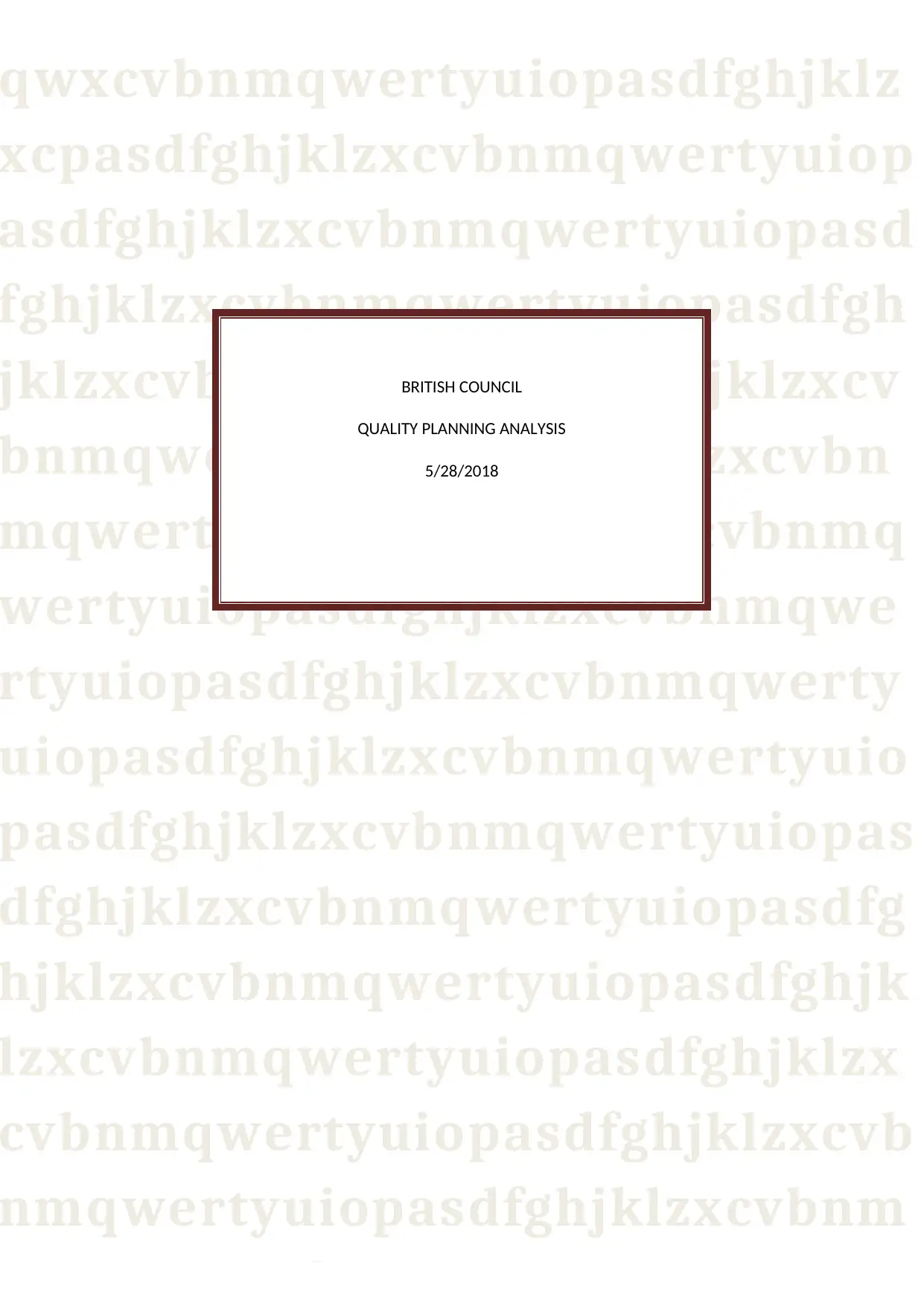
qwxcvbnmqwertyuiopasdfghjklz
xcpasdfghjklzxcvbnmqwertyuiop
asdfghjklzxcvbnmqwertyuiopasd
fghjklzxcvbnmqwertyuiopasdfgh
jklzxcvbnmrtyuiopasdfghjklzxcv
bnmqwertyuiopasdfghjklzxcvbn
mqwertyuiopasdfghjklzxcvbnmq
wertyuiopasdfghjklzxcvbnmqwe
rtyuiopasdfghjklzxcvbnmqwerty
uiopasdfghjklzxcvbnmqwertyuio
pasdfghjklzxcvbnmqwertyuiopas
dfghjklzxcvbnmqwertyuiopasdfg
hjklzxcvbnmqwertyuiopasdfghjk
lzxcvbnmqwertyuiopasdfghjklzx
cvbnmqwertyuiopasdfghjklzxcvb
nmqwertyuiopasdfghjklzxcvbnm
rtyuiopasdfghjklzxcvbnmqwerty
BRITISH COUNCIL
QUALITY PLANNING ANALYSIS
5/28/2018
xcpasdfghjklzxcvbnmqwertyuiop
asdfghjklzxcvbnmqwertyuiopasd
fghjklzxcvbnmqwertyuiopasdfgh
jklzxcvbnmrtyuiopasdfghjklzxcv
bnmqwertyuiopasdfghjklzxcvbn
mqwertyuiopasdfghjklzxcvbnmq
wertyuiopasdfghjklzxcvbnmqwe
rtyuiopasdfghjklzxcvbnmqwerty
uiopasdfghjklzxcvbnmqwertyuio
pasdfghjklzxcvbnmqwertyuiopas
dfghjklzxcvbnmqwertyuiopasdfg
hjklzxcvbnmqwertyuiopasdfghjk
lzxcvbnmqwertyuiopasdfghjklzx
cvbnmqwertyuiopasdfghjklzxcvb
nmqwertyuiopasdfghjklzxcvbnm
rtyuiopasdfghjklzxcvbnmqwerty
BRITISH COUNCIL
QUALITY PLANNING ANALYSIS
5/28/2018
Paraphrase This Document
Need a fresh take? Get an instant paraphrase of this document with our AI Paraphraser
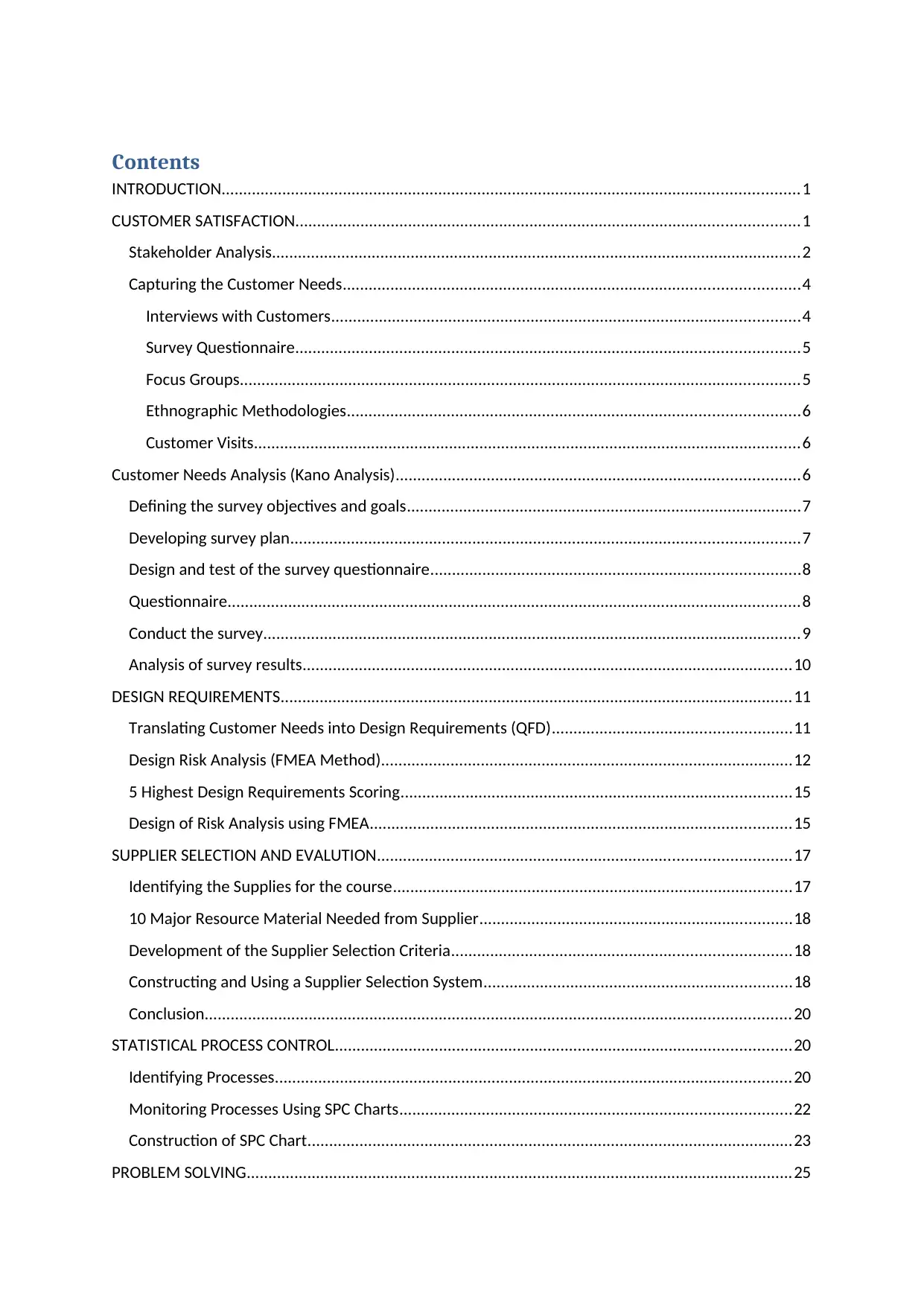
Contents
INTRODUCTION.....................................................................................................................................1
CUSTOMER SATISFACTION....................................................................................................................1
Stakeholder Analysis..........................................................................................................................2
Capturing the Customer Needs.........................................................................................................4
Interviews with Customers............................................................................................................4
Survey Questionnaire....................................................................................................................5
Focus Groups.................................................................................................................................5
Ethnographic Methodologies........................................................................................................6
Customer Visits..............................................................................................................................6
Customer Needs Analysis (Kano Analysis).............................................................................................6
Defining the survey objectives and goals...........................................................................................7
Developing survey plan.....................................................................................................................7
Design and test of the survey questionnaire.....................................................................................8
Questionnaire....................................................................................................................................8
Conduct the survey............................................................................................................................9
Analysis of survey results.................................................................................................................10
DESIGN REQUIREMENTS......................................................................................................................11
Translating Customer Needs into Design Requirements (QFD).......................................................11
Design Risk Analysis (FMEA Method)...............................................................................................12
5 Highest Design Requirements Scoring..........................................................................................15
Design of Risk Analysis using FMEA.................................................................................................15
SUPPLIER SELECTION AND EVALUTION...............................................................................................17
Identifying the Supplies for the course............................................................................................17
10 Major Resource Material Needed from Supplier........................................................................18
Development of the Supplier Selection Criteria..............................................................................18
Constructing and Using a Supplier Selection System.......................................................................18
Conclusion.......................................................................................................................................20
STATISTICAL PROCESS CONTROL.........................................................................................................20
Identifying Processes.......................................................................................................................20
Monitoring Processes Using SPC Charts..........................................................................................22
Construction of SPC Chart................................................................................................................23
PROBLEM SOLVING..............................................................................................................................25
INTRODUCTION.....................................................................................................................................1
CUSTOMER SATISFACTION....................................................................................................................1
Stakeholder Analysis..........................................................................................................................2
Capturing the Customer Needs.........................................................................................................4
Interviews with Customers............................................................................................................4
Survey Questionnaire....................................................................................................................5
Focus Groups.................................................................................................................................5
Ethnographic Methodologies........................................................................................................6
Customer Visits..............................................................................................................................6
Customer Needs Analysis (Kano Analysis).............................................................................................6
Defining the survey objectives and goals...........................................................................................7
Developing survey plan.....................................................................................................................7
Design and test of the survey questionnaire.....................................................................................8
Questionnaire....................................................................................................................................8
Conduct the survey............................................................................................................................9
Analysis of survey results.................................................................................................................10
DESIGN REQUIREMENTS......................................................................................................................11
Translating Customer Needs into Design Requirements (QFD).......................................................11
Design Risk Analysis (FMEA Method)...............................................................................................12
5 Highest Design Requirements Scoring..........................................................................................15
Design of Risk Analysis using FMEA.................................................................................................15
SUPPLIER SELECTION AND EVALUTION...............................................................................................17
Identifying the Supplies for the course............................................................................................17
10 Major Resource Material Needed from Supplier........................................................................18
Development of the Supplier Selection Criteria..............................................................................18
Constructing and Using a Supplier Selection System.......................................................................18
Conclusion.......................................................................................................................................20
STATISTICAL PROCESS CONTROL.........................................................................................................20
Identifying Processes.......................................................................................................................20
Monitoring Processes Using SPC Charts..........................................................................................22
Construction of SPC Chart................................................................................................................23
PROBLEM SOLVING..............................................................................................................................25

Brainstorming..................................................................................................................................26
Causes of problem...........................................................................................................................26
Why-why diagram...........................................................................................................................27
Check Sheet.....................................................................................................................................27
Pareto Diagram................................................................................................................................28
REFERENCES........................................................................................................................................28
Causes of problem...........................................................................................................................26
Why-why diagram...........................................................................................................................27
Check Sheet.....................................................................................................................................27
Pareto Diagram................................................................................................................................28
REFERENCES........................................................................................................................................28
⊘ This is a preview!⊘
Do you want full access?
Subscribe today to unlock all pages.

Trusted by 1+ million students worldwide
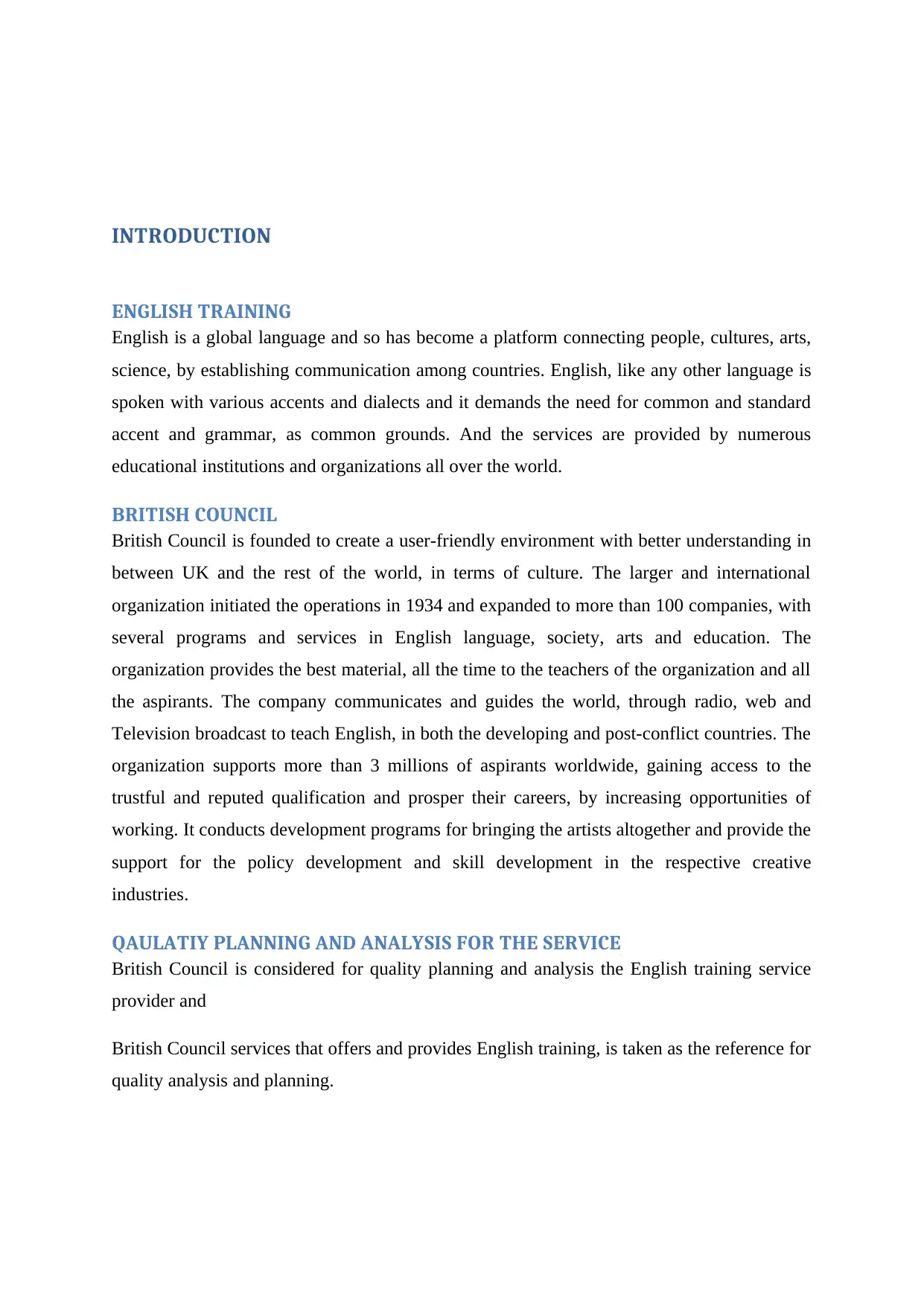
INTRODUCTION
ENGLISH TRAINING
English is a global language and so has become a platform connecting people, cultures, arts,
science, by establishing communication among countries. English, like any other language is
spoken with various accents and dialects and it demands the need for common and standard
accent and grammar, as common grounds. And the services are provided by numerous
educational institutions and organizations all over the world.
BRITISH COUNCIL
British Council is founded to create a user-friendly environment with better understanding in
between UK and the rest of the world, in terms of culture. The larger and international
organization initiated the operations in 1934 and expanded to more than 100 companies, with
several programs and services in English language, society, arts and education. The
organization provides the best material, all the time to the teachers of the organization and all
the aspirants. The company communicates and guides the world, through radio, web and
Television broadcast to teach English, in both the developing and post-conflict countries. The
organization supports more than 3 millions of aspirants worldwide, gaining access to the
trustful and reputed qualification and prosper their careers, by increasing opportunities of
working. It conducts development programs for bringing the artists altogether and provide the
support for the policy development and skill development in the respective creative
industries.
QAULATIY PLANNING AND ANALYSIS FOR THE SERVICE
British Council is considered for quality planning and analysis the English training service
provider and
British Council services that offers and provides English training, is taken as the reference for
quality analysis and planning.
ENGLISH TRAINING
English is a global language and so has become a platform connecting people, cultures, arts,
science, by establishing communication among countries. English, like any other language is
spoken with various accents and dialects and it demands the need for common and standard
accent and grammar, as common grounds. And the services are provided by numerous
educational institutions and organizations all over the world.
BRITISH COUNCIL
British Council is founded to create a user-friendly environment with better understanding in
between UK and the rest of the world, in terms of culture. The larger and international
organization initiated the operations in 1934 and expanded to more than 100 companies, with
several programs and services in English language, society, arts and education. The
organization provides the best material, all the time to the teachers of the organization and all
the aspirants. The company communicates and guides the world, through radio, web and
Television broadcast to teach English, in both the developing and post-conflict countries. The
organization supports more than 3 millions of aspirants worldwide, gaining access to the
trustful and reputed qualification and prosper their careers, by increasing opportunities of
working. It conducts development programs for bringing the artists altogether and provide the
support for the policy development and skill development in the respective creative
industries.
QAULATIY PLANNING AND ANALYSIS FOR THE SERVICE
British Council is considered for quality planning and analysis the English training service
provider and
British Council services that offers and provides English training, is taken as the reference for
quality analysis and planning.
Paraphrase This Document
Need a fresh take? Get an instant paraphrase of this document with our AI Paraphraser
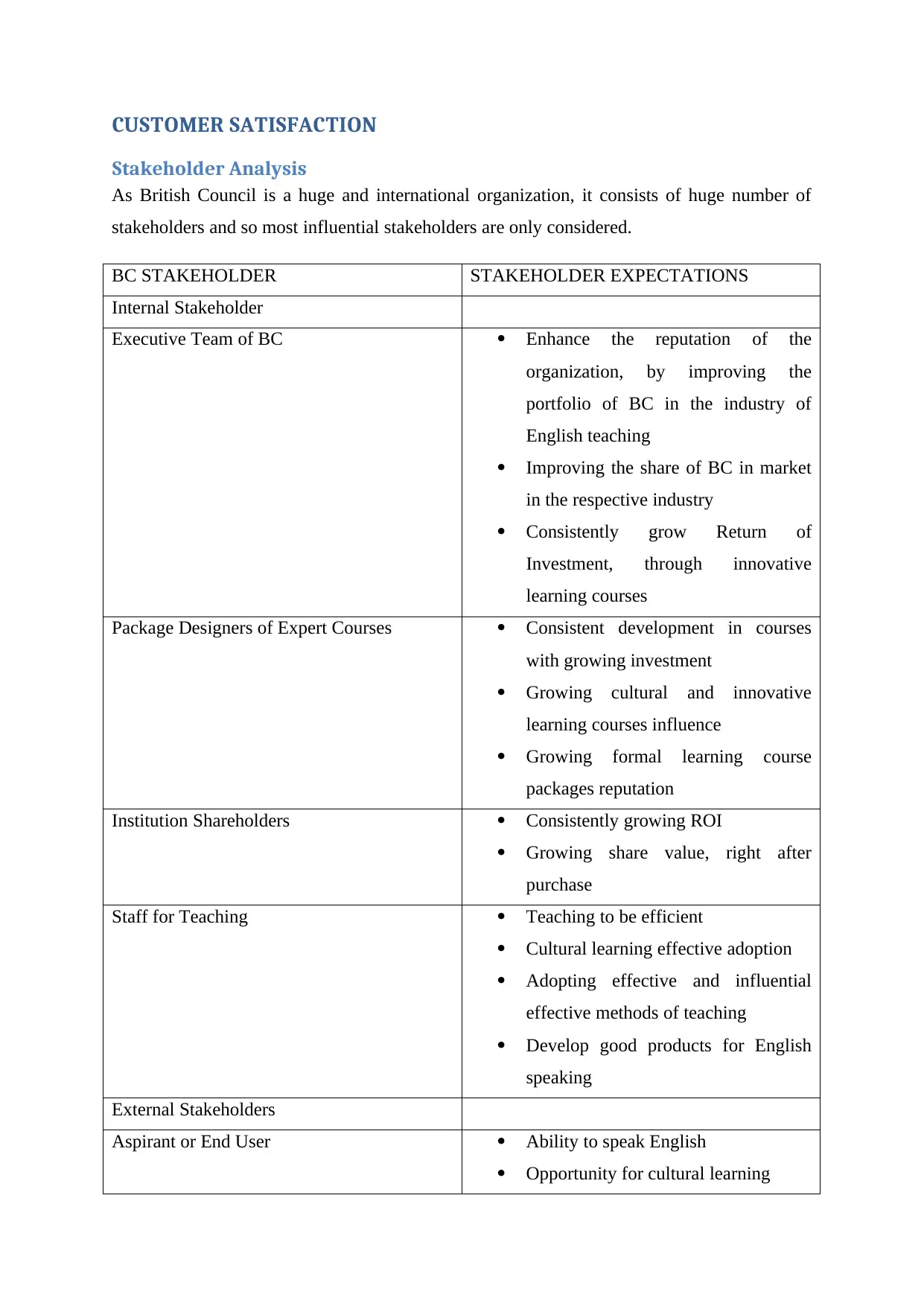
CUSTOMER SATISFACTION
Stakeholder Analysis
As British Council is a huge and international organization, it consists of huge number of
stakeholders and so most influential stakeholders are only considered.
BC STAKEHOLDER STAKEHOLDER EXPECTATIONS
Internal Stakeholder
Executive Team of BC Enhance the reputation of the
organization, by improving the
portfolio of BC in the industry of
English teaching
Improving the share of BC in market
in the respective industry
Consistently grow Return of
Investment, through innovative
learning courses
Package Designers of Expert Courses Consistent development in courses
with growing investment
Growing cultural and innovative
learning courses influence
Growing formal learning course
packages reputation
Institution Shareholders Consistently growing ROI
Growing share value, right after
purchase
Staff for Teaching Teaching to be efficient
Cultural learning effective adoption
Adopting effective and influential
effective methods of teaching
Develop good products for English
speaking
External Stakeholders
Aspirant or End User Ability to speak English
Opportunity for cultural learning
Stakeholder Analysis
As British Council is a huge and international organization, it consists of huge number of
stakeholders and so most influential stakeholders are only considered.
BC STAKEHOLDER STAKEHOLDER EXPECTATIONS
Internal Stakeholder
Executive Team of BC Enhance the reputation of the
organization, by improving the
portfolio of BC in the industry of
English teaching
Improving the share of BC in market
in the respective industry
Consistently grow Return of
Investment, through innovative
learning courses
Package Designers of Expert Courses Consistent development in courses
with growing investment
Growing cultural and innovative
learning courses influence
Growing formal learning course
packages reputation
Institution Shareholders Consistently growing ROI
Growing share value, right after
purchase
Staff for Teaching Teaching to be efficient
Cultural learning effective adoption
Adopting effective and influential
effective methods of teaching
Develop good products for English
speaking
External Stakeholders
Aspirant or End User Ability to speak English
Opportunity for cultural learning
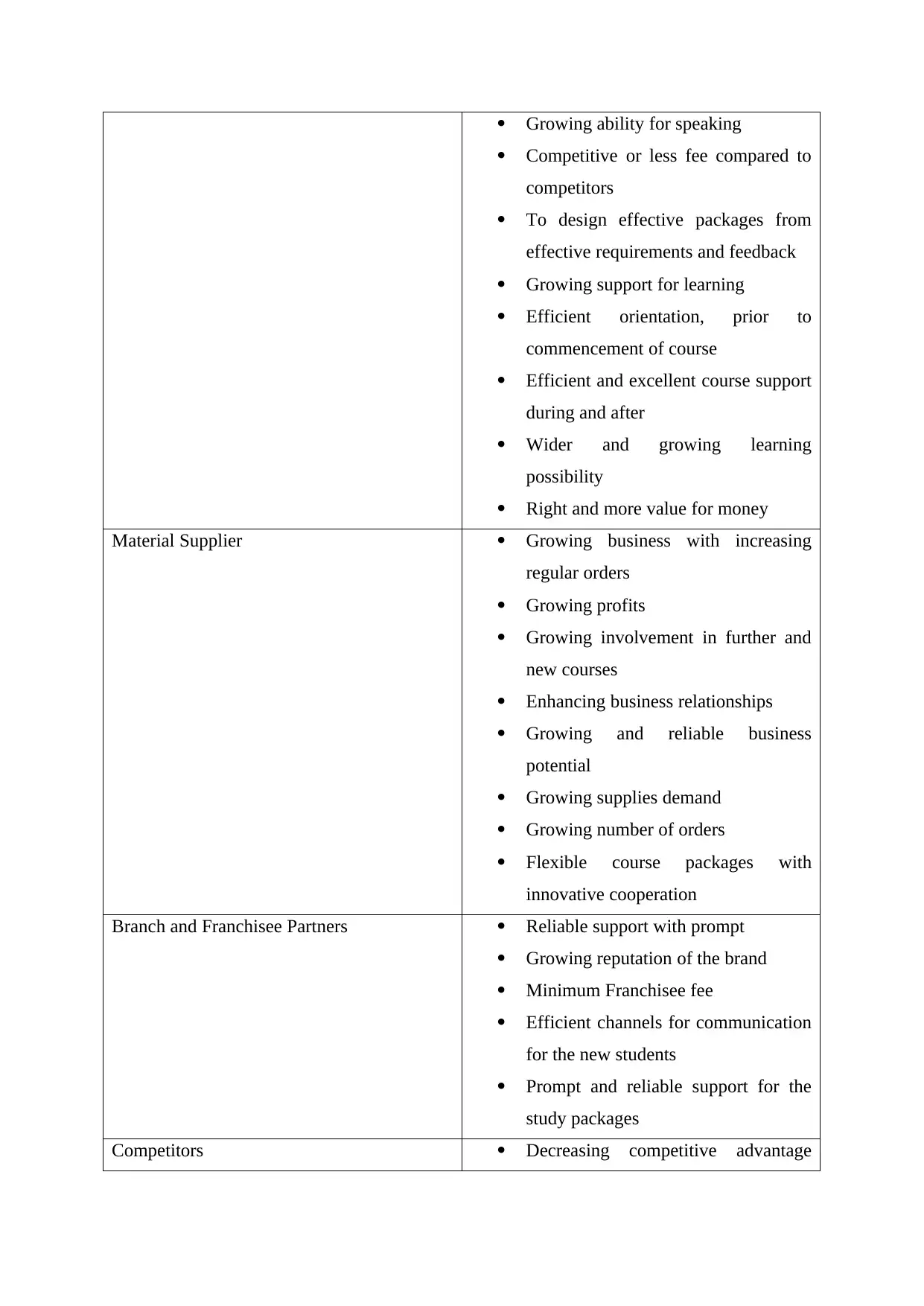
Growing ability for speaking
Competitive or less fee compared to
competitors
To design effective packages from
effective requirements and feedback
Growing support for learning
Efficient orientation, prior to
commencement of course
Efficient and excellent course support
during and after
Wider and growing learning
possibility
Right and more value for money
Material Supplier Growing business with increasing
regular orders
Growing profits
Growing involvement in further and
new courses
Enhancing business relationships
Growing and reliable business
potential
Growing supplies demand
Growing number of orders
Flexible course packages with
innovative cooperation
Branch and Franchisee Partners Reliable support with prompt
Growing reputation of the brand
Minimum Franchisee fee
Efficient channels for communication
for the new students
Prompt and reliable support for the
study packages
Competitors Decreasing competitive advantage
Competitive or less fee compared to
competitors
To design effective packages from
effective requirements and feedback
Growing support for learning
Efficient orientation, prior to
commencement of course
Efficient and excellent course support
during and after
Wider and growing learning
possibility
Right and more value for money
Material Supplier Growing business with increasing
regular orders
Growing profits
Growing involvement in further and
new courses
Enhancing business relationships
Growing and reliable business
potential
Growing supplies demand
Growing number of orders
Flexible course packages with
innovative cooperation
Branch and Franchisee Partners Reliable support with prompt
Growing reputation of the brand
Minimum Franchisee fee
Efficient channels for communication
for the new students
Prompt and reliable support for the
study packages
Competitors Decreasing competitive advantage
⊘ This is a preview!⊘
Do you want full access?
Subscribe today to unlock all pages.

Trusted by 1+ million students worldwide
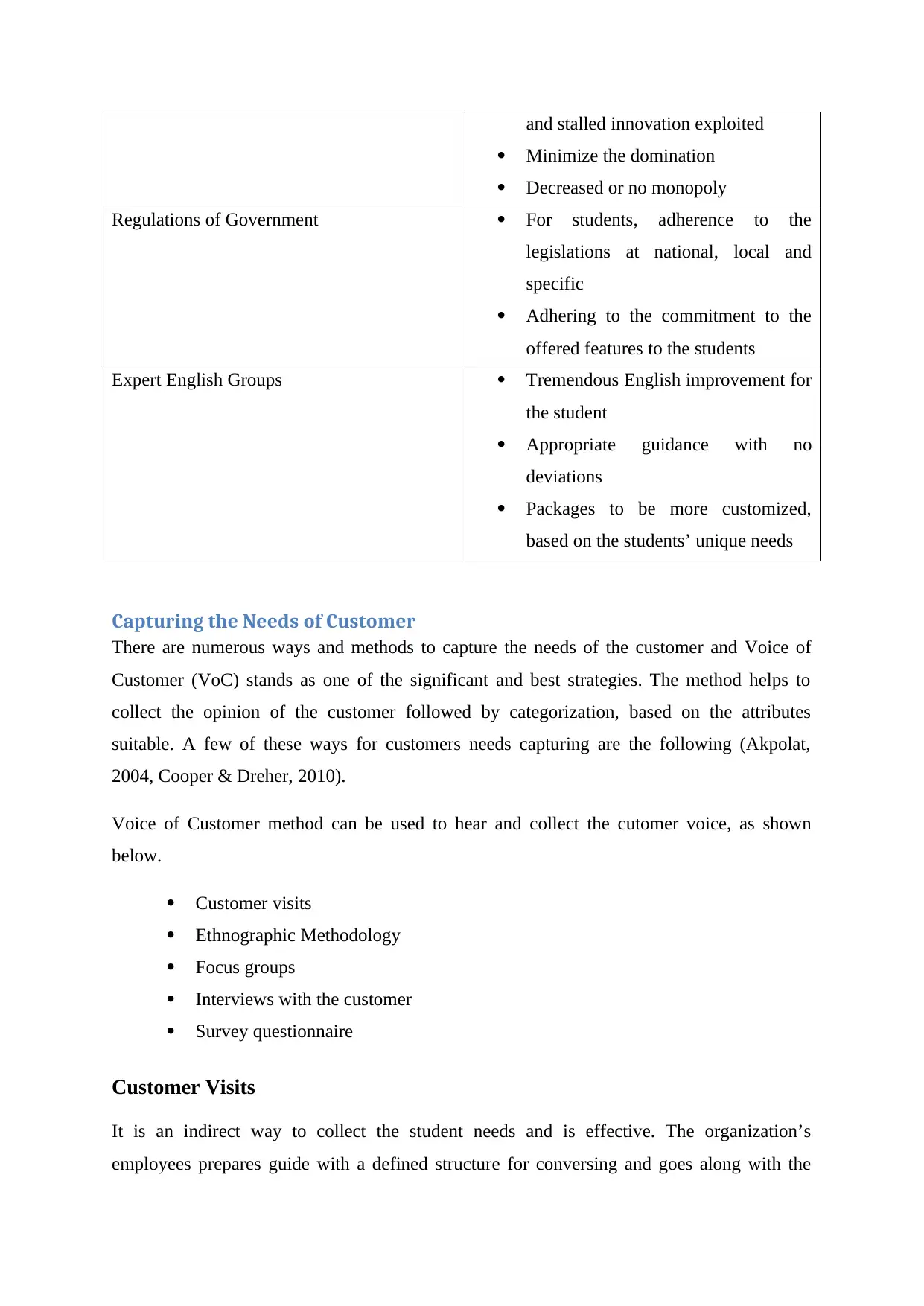
and stalled innovation exploited
Minimize the domination
Decreased or no monopoly
Regulations of Government For students, adherence to the
legislations at national, local and
specific
Adhering to the commitment to the
offered features to the students
Expert English Groups Tremendous English improvement for
the student
Appropriate guidance with no
deviations
Packages to be more customized,
based on the students’ unique needs
Capturing the Needs of Customer
There are numerous ways and methods to capture the needs of the customer and Voice of
Customer (VoC) stands as one of the significant and best strategies. The method helps to
collect the opinion of the customer followed by categorization, based on the attributes
suitable. A few of these ways for customers needs capturing are the following (Akpolat,
2004, Cooper & Dreher, 2010).
Voice of Customer method can be used to hear and collect the cutomer voice, as shown
below.
Customer visits
Ethnographic Methodology
Focus groups
Interviews with the customer
Survey questionnaire
Customer Visits
It is an indirect way to collect the student needs and is effective. The organization’s
employees prepares guide with a defined structure for conversing and goes along with the
Minimize the domination
Decreased or no monopoly
Regulations of Government For students, adherence to the
legislations at national, local and
specific
Adhering to the commitment to the
offered features to the students
Expert English Groups Tremendous English improvement for
the student
Appropriate guidance with no
deviations
Packages to be more customized,
based on the students’ unique needs
Capturing the Needs of Customer
There are numerous ways and methods to capture the needs of the customer and Voice of
Customer (VoC) stands as one of the significant and best strategies. The method helps to
collect the opinion of the customer followed by categorization, based on the attributes
suitable. A few of these ways for customers needs capturing are the following (Akpolat,
2004, Cooper & Dreher, 2010).
Voice of Customer method can be used to hear and collect the cutomer voice, as shown
below.
Customer visits
Ethnographic Methodology
Focus groups
Interviews with the customer
Survey questionnaire
Customer Visits
It is an indirect way to collect the student needs and is effective. The organization’s
employees prepares guide with a defined structure for conversing and goes along with the
Paraphrase This Document
Need a fresh take? Get an instant paraphrase of this document with our AI Paraphraser
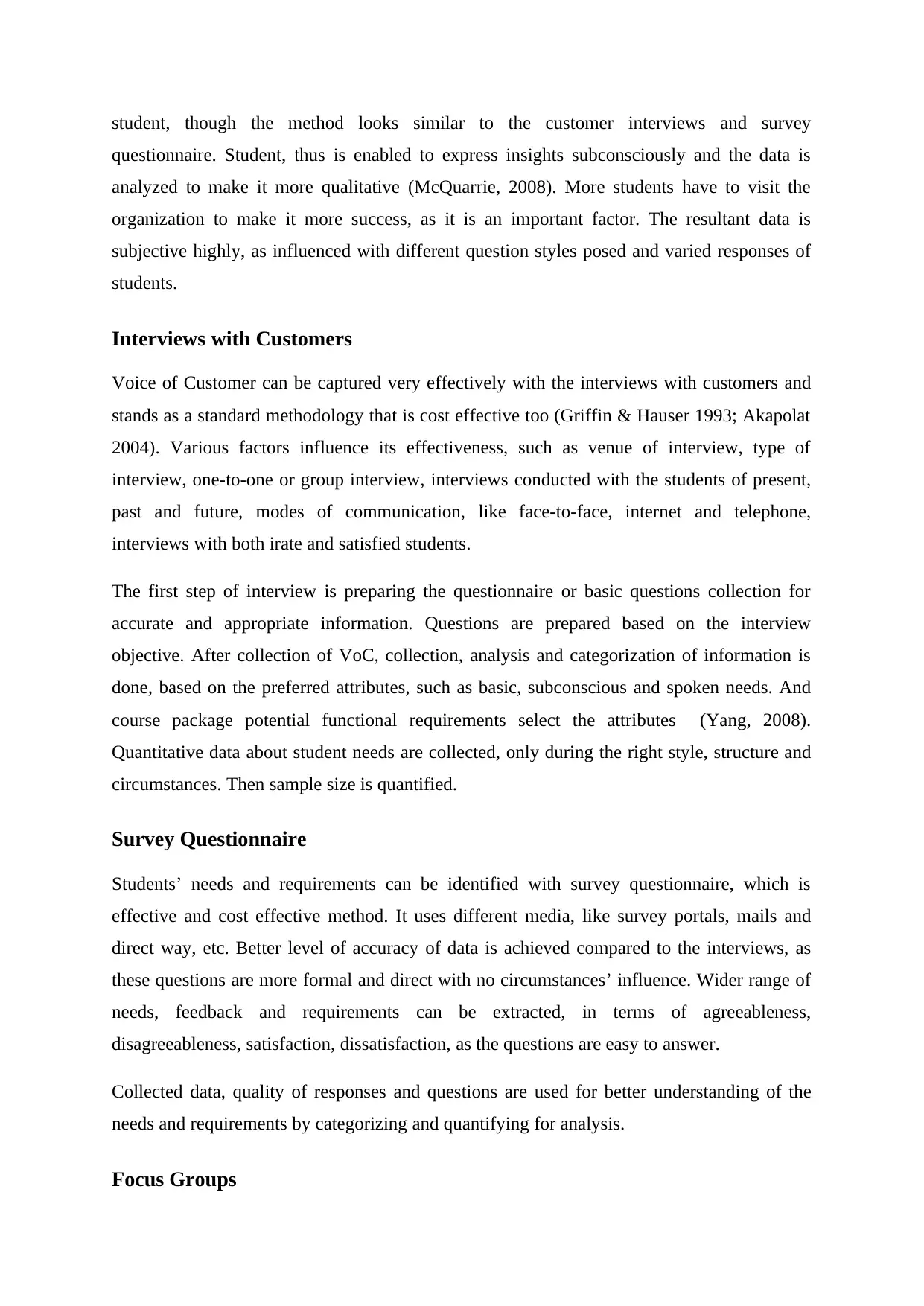
student, though the method looks similar to the customer interviews and survey
questionnaire. Student, thus is enabled to express insights subconsciously and the data is
analyzed to make it more qualitative (McQuarrie, 2008). More students have to visit the
organization to make it more success, as it is an important factor. The resultant data is
subjective highly, as influenced with different question styles posed and varied responses of
students.
Interviews with Customers
Voice of Customer can be captured very effectively with the interviews with customers and
stands as a standard methodology that is cost effective too (Griffin & Hauser 1993; Akapolat
2004). Various factors influence its effectiveness, such as venue of interview, type of
interview, one-to-one or group interview, interviews conducted with the students of present,
past and future, modes of communication, like face-to-face, internet and telephone,
interviews with both irate and satisfied students.
The first step of interview is preparing the questionnaire or basic questions collection for
accurate and appropriate information. Questions are prepared based on the interview
objective. After collection of VoC, collection, analysis and categorization of information is
done, based on the preferred attributes, such as basic, subconscious and spoken needs. And
course package potential functional requirements select the attributes (Yang, 2008).
Quantitative data about student needs are collected, only during the right style, structure and
circumstances. Then sample size is quantified.
Survey Questionnaire
Students’ needs and requirements can be identified with survey questionnaire, which is
effective and cost effective method. It uses different media, like survey portals, mails and
direct way, etc. Better level of accuracy of data is achieved compared to the interviews, as
these questions are more formal and direct with no circumstances’ influence. Wider range of
needs, feedback and requirements can be extracted, in terms of agreeableness,
disagreeableness, satisfaction, dissatisfaction, as the questions are easy to answer.
Collected data, quality of responses and questions are used for better understanding of the
needs and requirements by categorizing and quantifying for analysis.
Focus Groups
questionnaire. Student, thus is enabled to express insights subconsciously and the data is
analyzed to make it more qualitative (McQuarrie, 2008). More students have to visit the
organization to make it more success, as it is an important factor. The resultant data is
subjective highly, as influenced with different question styles posed and varied responses of
students.
Interviews with Customers
Voice of Customer can be captured very effectively with the interviews with customers and
stands as a standard methodology that is cost effective too (Griffin & Hauser 1993; Akapolat
2004). Various factors influence its effectiveness, such as venue of interview, type of
interview, one-to-one or group interview, interviews conducted with the students of present,
past and future, modes of communication, like face-to-face, internet and telephone,
interviews with both irate and satisfied students.
The first step of interview is preparing the questionnaire or basic questions collection for
accurate and appropriate information. Questions are prepared based on the interview
objective. After collection of VoC, collection, analysis and categorization of information is
done, based on the preferred attributes, such as basic, subconscious and spoken needs. And
course package potential functional requirements select the attributes (Yang, 2008).
Quantitative data about student needs are collected, only during the right style, structure and
circumstances. Then sample size is quantified.
Survey Questionnaire
Students’ needs and requirements can be identified with survey questionnaire, which is
effective and cost effective method. It uses different media, like survey portals, mails and
direct way, etc. Better level of accuracy of data is achieved compared to the interviews, as
these questions are more formal and direct with no circumstances’ influence. Wider range of
needs, feedback and requirements can be extracted, in terms of agreeableness,
disagreeableness, satisfaction, dissatisfaction, as the questions are easy to answer.
Collected data, quality of responses and questions are used for better understanding of the
needs and requirements by categorizing and quantifying for analysis.
Focus Groups
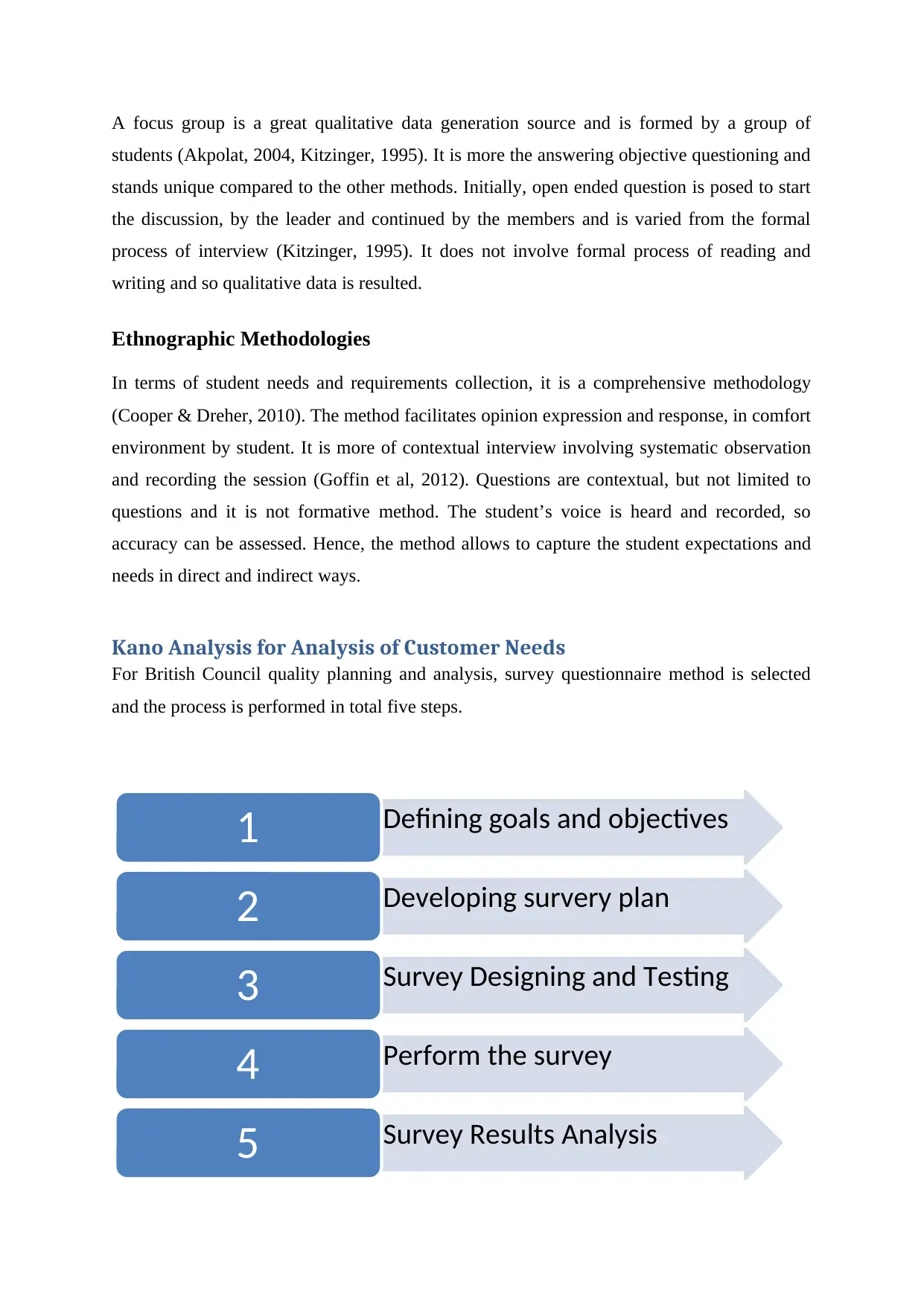
A focus group is a great qualitative data generation source and is formed by a group of
students (Akpolat, 2004, Kitzinger, 1995). It is more the answering objective questioning and
stands unique compared to the other methods. Initially, open ended question is posed to start
the discussion, by the leader and continued by the members and is varied from the formal
process of interview (Kitzinger, 1995). It does not involve formal process of reading and
writing and so qualitative data is resulted.
Ethnographic Methodologies
In terms of student needs and requirements collection, it is a comprehensive methodology
(Cooper & Dreher, 2010). The method facilitates opinion expression and response, in comfort
environment by student. It is more of contextual interview involving systematic observation
and recording the session (Goffin et al, 2012). Questions are contextual, but not limited to
questions and it is not formative method. The student’s voice is heard and recorded, so
accuracy can be assessed. Hence, the method allows to capture the student expectations and
needs in direct and indirect ways.
Kano Analysis for Analysis of Customer Needs
For British Council quality planning and analysis, survey questionnaire method is selected
and the process is performed in total five steps.
Defining goals and objectives1
Developing survery plan2
Survey Designing and Testing3
Perform the survey4
Survey Results Analysis5
students (Akpolat, 2004, Kitzinger, 1995). It is more the answering objective questioning and
stands unique compared to the other methods. Initially, open ended question is posed to start
the discussion, by the leader and continued by the members and is varied from the formal
process of interview (Kitzinger, 1995). It does not involve formal process of reading and
writing and so qualitative data is resulted.
Ethnographic Methodologies
In terms of student needs and requirements collection, it is a comprehensive methodology
(Cooper & Dreher, 2010). The method facilitates opinion expression and response, in comfort
environment by student. It is more of contextual interview involving systematic observation
and recording the session (Goffin et al, 2012). Questions are contextual, but not limited to
questions and it is not formative method. The student’s voice is heard and recorded, so
accuracy can be assessed. Hence, the method allows to capture the student expectations and
needs in direct and indirect ways.
Kano Analysis for Analysis of Customer Needs
For British Council quality planning and analysis, survey questionnaire method is selected
and the process is performed in total five steps.
Defining goals and objectives1
Developing survery plan2
Survey Designing and Testing3
Perform the survey4
Survey Results Analysis5
⊘ This is a preview!⊘
Do you want full access?
Subscribe today to unlock all pages.

Trusted by 1+ million students worldwide
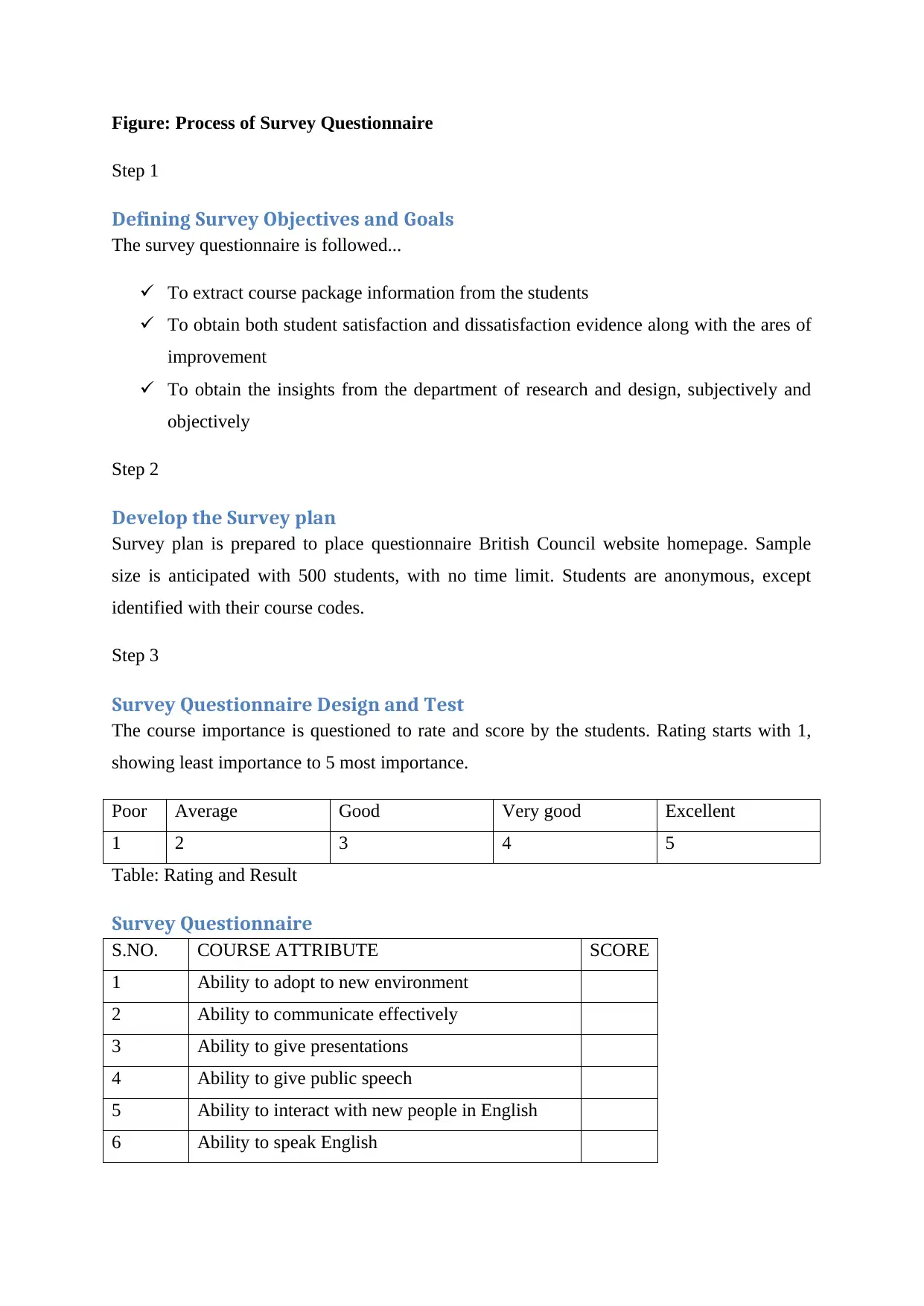
Figure: Process of Survey Questionnaire
Step 1
Defining Survey Objectives and Goals
The survey questionnaire is followed...
To extract course package information from the students
To obtain both student satisfaction and dissatisfaction evidence along with the ares of
improvement
To obtain the insights from the department of research and design, subjectively and
objectively
Step 2
Develop the Survey plan
Survey plan is prepared to place questionnaire British Council website homepage. Sample
size is anticipated with 500 students, with no time limit. Students are anonymous, except
identified with their course codes.
Step 3
Survey Questionnaire Design and Test
The course importance is questioned to rate and score by the students. Rating starts with 1,
showing least importance to 5 most importance.
Poor Average Good Very good Excellent
1 2 3 4 5
Table: Rating and Result
Survey Questionnaire
S.NO. COURSE ATTRIBUTE SCORE
1 Ability to adopt to new environment
2 Ability to communicate effectively
3 Ability to give presentations
4 Ability to give public speech
5 Ability to interact with new people in English
6 Ability to speak English
Step 1
Defining Survey Objectives and Goals
The survey questionnaire is followed...
To extract course package information from the students
To obtain both student satisfaction and dissatisfaction evidence along with the ares of
improvement
To obtain the insights from the department of research and design, subjectively and
objectively
Step 2
Develop the Survey plan
Survey plan is prepared to place questionnaire British Council website homepage. Sample
size is anticipated with 500 students, with no time limit. Students are anonymous, except
identified with their course codes.
Step 3
Survey Questionnaire Design and Test
The course importance is questioned to rate and score by the students. Rating starts with 1,
showing least importance to 5 most importance.
Poor Average Good Very good Excellent
1 2 3 4 5
Table: Rating and Result
Survey Questionnaire
S.NO. COURSE ATTRIBUTE SCORE
1 Ability to adopt to new environment
2 Ability to communicate effectively
3 Ability to give presentations
4 Ability to give public speech
5 Ability to interact with new people in English
6 Ability to speak English
Paraphrase This Document
Need a fresh take? Get an instant paraphrase of this document with our AI Paraphraser
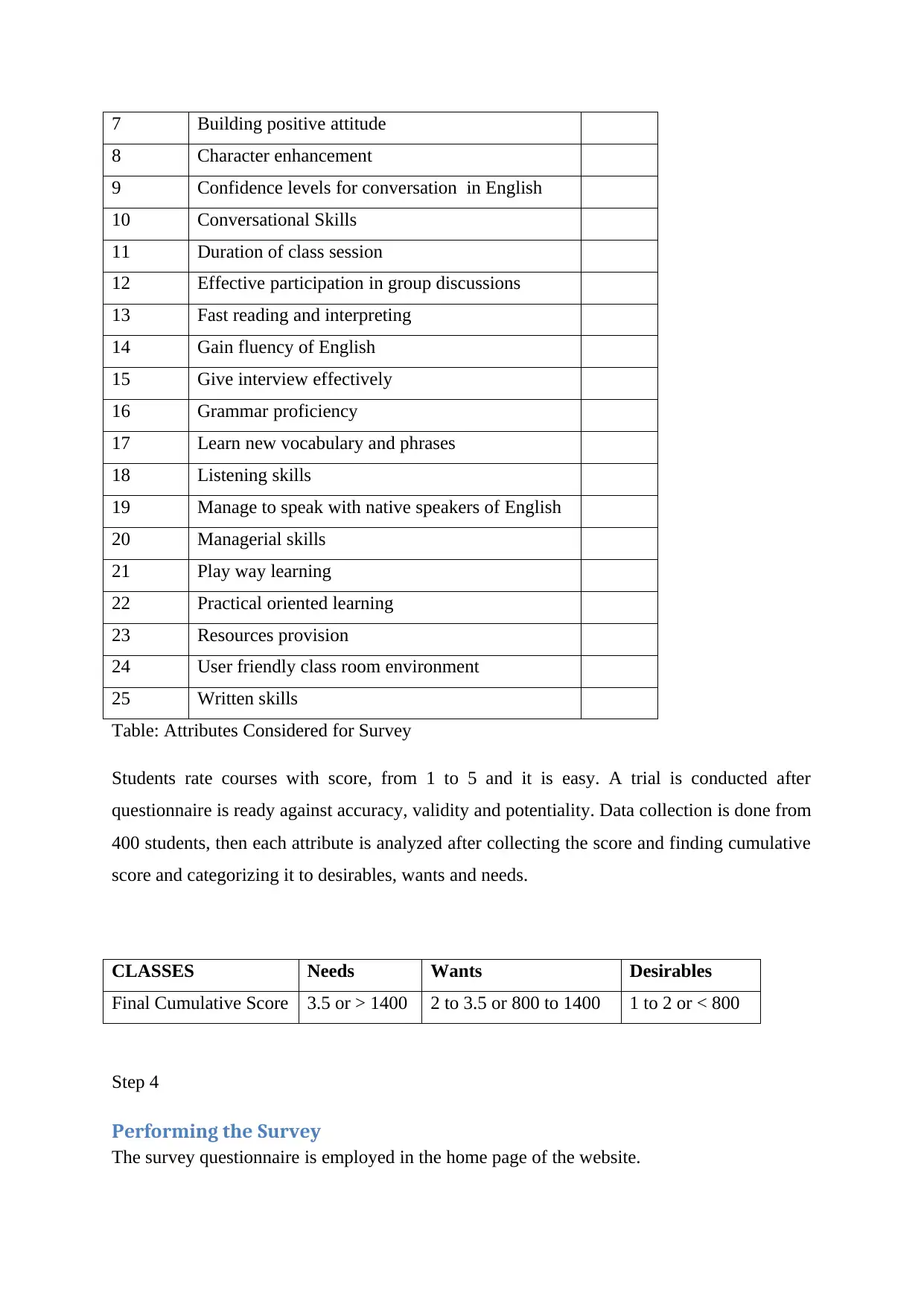
7 Building positive attitude
8 Character enhancement
9 Confidence levels for conversation in English
10 Conversational Skills
11 Duration of class session
12 Effective participation in group discussions
13 Fast reading and interpreting
14 Gain fluency of English
15 Give interview effectively
16 Grammar proficiency
17 Learn new vocabulary and phrases
18 Listening skills
19 Manage to speak with native speakers of English
20 Managerial skills
21 Play way learning
22 Practical oriented learning
23 Resources provision
24 User friendly class room environment
25 Written skills
Table: Attributes Considered for Survey
Students rate courses with score, from 1 to 5 and it is easy. A trial is conducted after
questionnaire is ready against accuracy, validity and potentiality. Data collection is done from
400 students, then each attribute is analyzed after collecting the score and finding cumulative
score and categorizing it to desirables, wants and needs.
CLASSES Needs Wants Desirables
Final Cumulative Score 3.5 or > 1400 2 to 3.5 or 800 to 1400 1 to 2 or < 800
Step 4
Performing the Survey
The survey questionnaire is employed in the home page of the website.
8 Character enhancement
9 Confidence levels for conversation in English
10 Conversational Skills
11 Duration of class session
12 Effective participation in group discussions
13 Fast reading and interpreting
14 Gain fluency of English
15 Give interview effectively
16 Grammar proficiency
17 Learn new vocabulary and phrases
18 Listening skills
19 Manage to speak with native speakers of English
20 Managerial skills
21 Play way learning
22 Practical oriented learning
23 Resources provision
24 User friendly class room environment
25 Written skills
Table: Attributes Considered for Survey
Students rate courses with score, from 1 to 5 and it is easy. A trial is conducted after
questionnaire is ready against accuracy, validity and potentiality. Data collection is done from
400 students, then each attribute is analyzed after collecting the score and finding cumulative
score and categorizing it to desirables, wants and needs.
CLASSES Needs Wants Desirables
Final Cumulative Score 3.5 or > 1400 2 to 3.5 or 800 to 1400 1 to 2 or < 800
Step 4
Performing the Survey
The survey questionnaire is employed in the home page of the website.
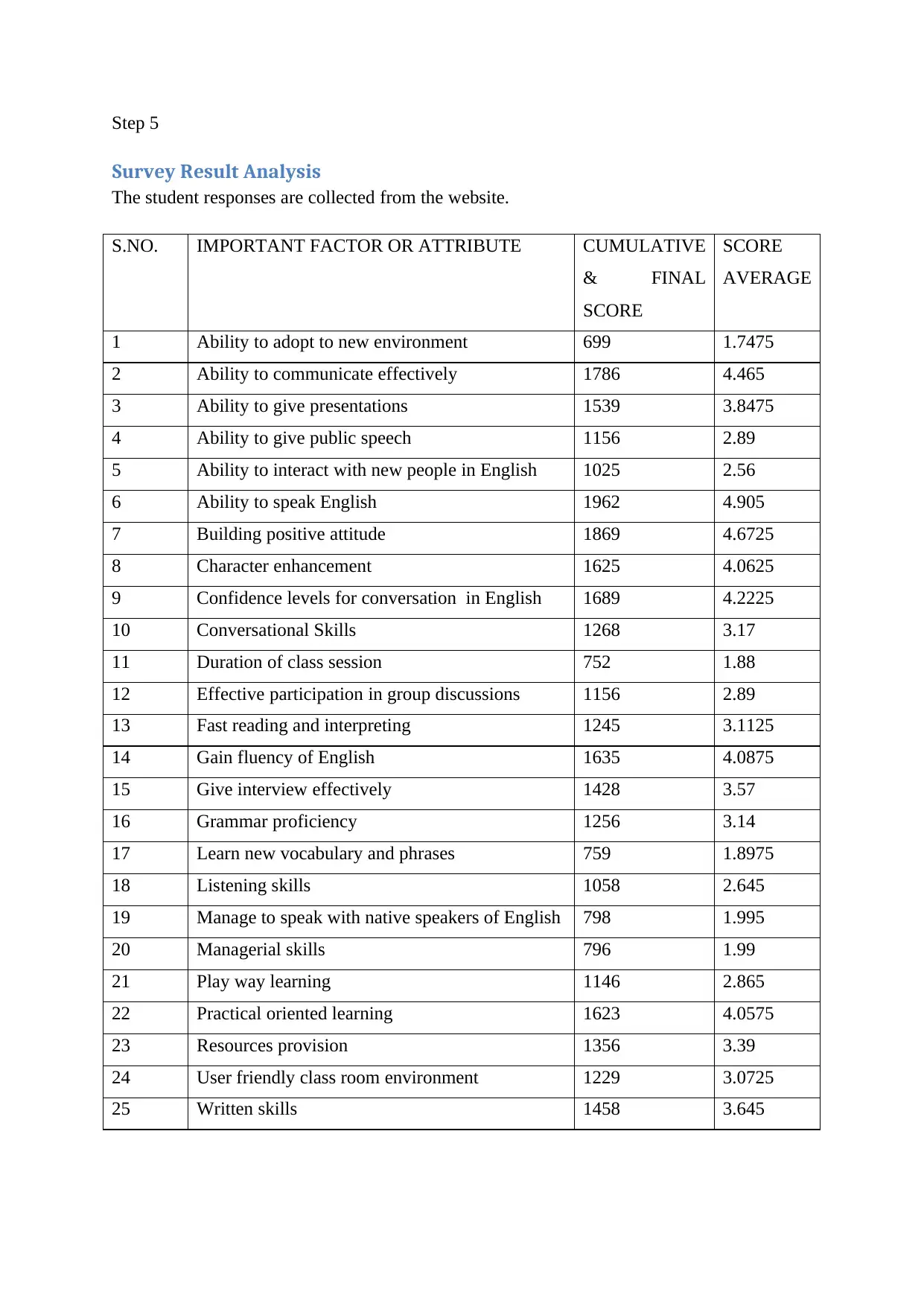
Step 5
Survey Result Analysis
The student responses are collected from the website.
S.NO. IMPORTANT FACTOR OR ATTRIBUTE CUMULATIVE
& FINAL
SCORE
SCORE
AVERAGE
1 Ability to adopt to new environment 699 1.7475
2 Ability to communicate effectively 1786 4.465
3 Ability to give presentations 1539 3.8475
4 Ability to give public speech 1156 2.89
5 Ability to interact with new people in English 1025 2.56
6 Ability to speak English 1962 4.905
7 Building positive attitude 1869 4.6725
8 Character enhancement 1625 4.0625
9 Confidence levels for conversation in English 1689 4.2225
10 Conversational Skills 1268 3.17
11 Duration of class session 752 1.88
12 Effective participation in group discussions 1156 2.89
13 Fast reading and interpreting 1245 3.1125
14 Gain fluency of English 1635 4.0875
15 Give interview effectively 1428 3.57
16 Grammar proficiency 1256 3.14
17 Learn new vocabulary and phrases 759 1.8975
18 Listening skills 1058 2.645
19 Manage to speak with native speakers of English 798 1.995
20 Managerial skills 796 1.99
21 Play way learning 1146 2.865
22 Practical oriented learning 1623 4.0575
23 Resources provision 1356 3.39
24 User friendly class room environment 1229 3.0725
25 Written skills 1458 3.645
Survey Result Analysis
The student responses are collected from the website.
S.NO. IMPORTANT FACTOR OR ATTRIBUTE CUMULATIVE
& FINAL
SCORE
SCORE
AVERAGE
1 Ability to adopt to new environment 699 1.7475
2 Ability to communicate effectively 1786 4.465
3 Ability to give presentations 1539 3.8475
4 Ability to give public speech 1156 2.89
5 Ability to interact with new people in English 1025 2.56
6 Ability to speak English 1962 4.905
7 Building positive attitude 1869 4.6725
8 Character enhancement 1625 4.0625
9 Confidence levels for conversation in English 1689 4.2225
10 Conversational Skills 1268 3.17
11 Duration of class session 752 1.88
12 Effective participation in group discussions 1156 2.89
13 Fast reading and interpreting 1245 3.1125
14 Gain fluency of English 1635 4.0875
15 Give interview effectively 1428 3.57
16 Grammar proficiency 1256 3.14
17 Learn new vocabulary and phrases 759 1.8975
18 Listening skills 1058 2.645
19 Manage to speak with native speakers of English 798 1.995
20 Managerial skills 796 1.99
21 Play way learning 1146 2.865
22 Practical oriented learning 1623 4.0575
23 Resources provision 1356 3.39
24 User friendly class room environment 1229 3.0725
25 Written skills 1458 3.645
⊘ This is a preview!⊘
Do you want full access?
Subscribe today to unlock all pages.

Trusted by 1+ million students worldwide
1 out of 31
Related Documents
Your All-in-One AI-Powered Toolkit for Academic Success.
+13062052269
info@desklib.com
Available 24*7 on WhatsApp / Email
![[object Object]](/_next/static/media/star-bottom.7253800d.svg)
Unlock your academic potential
Copyright © 2020–2025 A2Z Services. All Rights Reserved. Developed and managed by ZUCOL.





